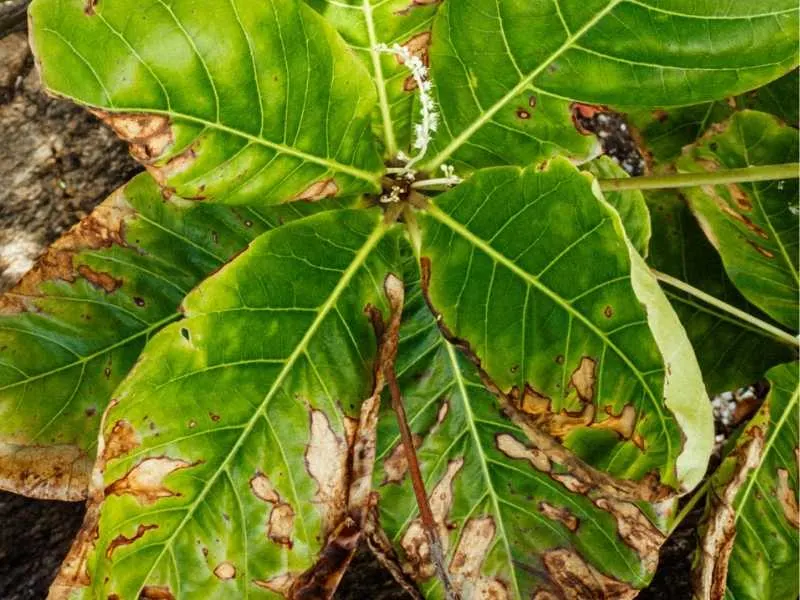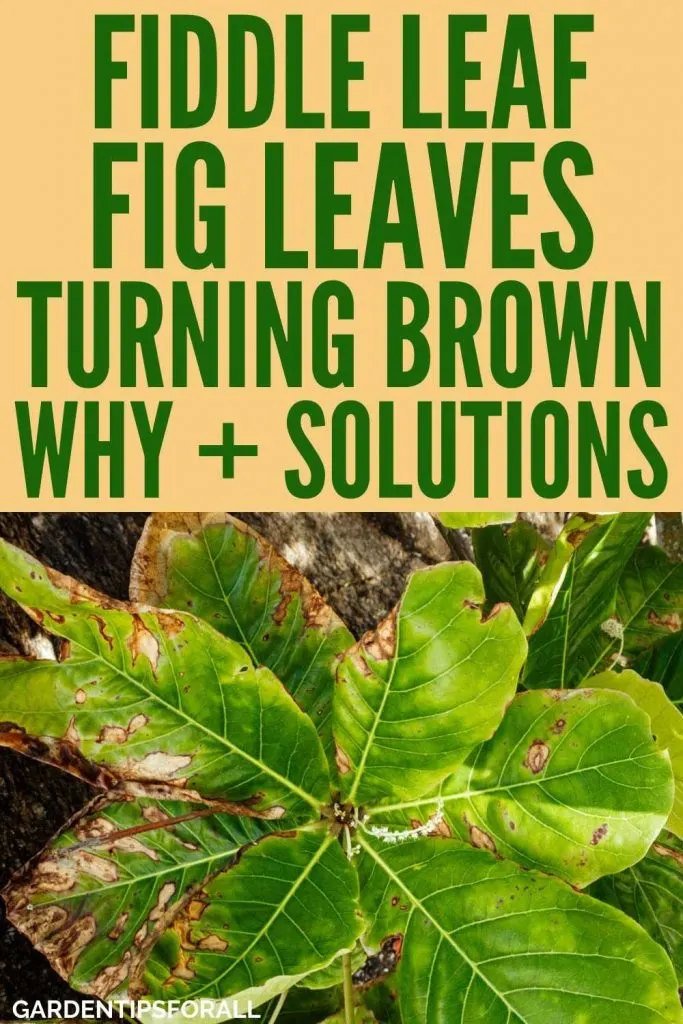Fiddle Leaf Fig Leaf Turning Brown – 5 Reasons + Solutions
Fiddle leaf figs are beautiful, robust and downright majestic. It can be super upsetting to see your fiddle fig leaves turn brown, but the good news is that with proper knowledge, love and care, your plant will be back to its former happy self. The earlier you identify the problem, the sooner you can take remedial actions.
Fiddle leaf fig leaves turning brown is quite a common occurrence. There is more than one reason why this happens. Brown spots can occur because of root rot, bacterial infection, sunburn, infestation, dryness due to underwatering, etc.
Below are some of the reasons why brown spots on fiddle leaf fig leaves occur. This way, you can diagnose what’s causing brown spots in your plant and take steps to prevent it or provide appropriate solutions.

Related Articles:
- Fiddle Leaf Fig Root Rot – Causes + Fixes
- Yellow Elephant Ear Leaves – Reasons Why and Solutions
- Are Fiddle Leaf Fig Trees Toxic to Cats?
- Why are My Peace Lily Flowers Turning Brown?
Fiddle Fig Leaves Turning Brown – 5 Reasons and Solutions
#1. Root Rot
When the roots of your fiddle leaf figs sit in too much water, fungal infection is bound to set in.
Overwatering once in a while is alright, but if you overwater far too frequently, you will have rotten fiddle leaf fig roots to deal with. Poor drainage could also lead to root rot in fiddle leaf fig, which then spreads to the leaves.
Examine your fiddle leaf figs. If you see dark brown spots on your plant that start around the edges or the base, it points to root rot.
Rotten roots show up as mushy and slimy with black or brown spots. Further, you may notice a foul smell emanating from the plant. Another telltale sign of rot is droopy fiddle leaf fig leaves.
If you see that happening, your plant is definitely in trouble, and you need to inspect the roots and tackle the problem immediately.
Solution
Overwatering and poor drainage are the culprits behind root rot. If there are just a few brown spots, you need to let the plant dry out for a few weeks. Give it time for the roots to recover before you water again. You can snip the affected leaves and leave your fiddle figs out in sufficient light.
If there are too many brown spots, you have to get rid of the brown, mushy roots along with the affected leaves and then repot your plant. Just make sure you don’t overwater again.
Poor drainage is another big culprit of root rot. When you are repotting, you should use a well-draining soil or pot with plenty of drainage holes. A well-aerating soil will give the roots plenty of room to breathe and space for the excess water to flow out.
#2. Bacterial Infection
You need to have a bit of an expert eye to distinguish the fiddle fig leaves turning brown due to root rot from the one caused by a bacterial infection.
While root rot is more common in older leaves, the bacterial infection is more apparent in the newer, younger leaves. And apart from the brown spots, your fiddle fig leaves will also start to turn yellow.
As in the case of root rot, your leaves will droop and eventually fall off from the top as well as the bottom.
If the older leaves look healthy, but it’s the newer leaves that are mostly affected, then a bacterial infection is to blame.
The bad news is, a bacterial infection is a lot tougher to deal with than root rot. However, if you spot the infection in the early stages, you can still salvage your plant.
Solution
You will need to remove the affected and repot your fiddle leaf fig with fresh, well draining soil. After repotting, place your plant in a spot that receives plenty of sunlight. Also, postpone watering till your plant recovers completely.
#3. Dryness and Underwatering
If dryness is the reason behind your fiddle leaf figs turning brown, it is a lot easier to spot. You can see the leaves of your fiddle leaf figs turning a tan color and becoming all crispy, beginning at the edge of the leaf.
It will keep progressing and work its way in until the leaves fall off. The plant itself will look dry and wilted with curled leaves.
Solution
Firstly, how long ago did you water your plant last? Has it been longer than two weeks? Then, touch the soil. If it feels too dry, it needs some moisture.
Underwatering can also be caused by being too stingy with water. Remember, the entire root ball should be soaked with water in each watering session. The excess water should drain through the holes at the bottom of the pot.
You should also assess where your plant is located. If it is near a heating vent or in a spot that receives intense sunlight, move it to a more ideal location.
You need to then give your plant some water. Water your plant thoroughly and keep doing it once a week. Misting twice a week helps as well. Another option is to run a humidifier near the plant to enhance the moisture in the air.
If it’s summertime or your plant is located in a spot where it receives plenty of sunlight, it is going to need a lot more water. So, you will have to water more than you did before.
Check your soil to see if it is properly aerated to ensure that your plant is receiving enough water to keep it healthy and thriving.
#4. Pest Infestation/Insect Damage
Brown spots could also develop on your fiddle figs because of insect damage. The good news though is, it is far less frequent and very easy to spot!
The obvious giveaway is the presence of dark spots on the leaves, which eventually turn into holes. Take a magnifying glass and look for webs or small insects on the plants. While you are at it, don’t forget to inspect the underside of the leaves as well.
Spider mites, aphids, mealybugs, fungus gnats are just a few insects that could be damaging your lovely fiddle figs. If you notice insects or webs, don’t panic, they are rather easy to get rid of.
Solution
To eliminate the annoying pests, I suggest you go with neem oil. Other remedies that work are organic insecticide soap or a mixture of water and dish soap.
Spray the neem oil or the insecticide on the leaves of your fiddle leaf figs. Take care to spray on the underside of the leaves and the areas where the leaves are joined to the stem.
You will do well to keep your plant outside as neem oil has an unpleasant smell. Observe your plant after a week or two. If you still notice an infestation, spray again.
#5. Sunburn
Fiddle leaf figs that are sunburned can take the form of white, yellow to light brown leaves – anywhere between this range of colors. If you notice your leaves looking bleached with light brown spots, they are getting more sunlight than they should.
When you bring your fiddle leaf fig home from the nursery, do not put it out in the sun immediately. You need to allow your plant to get acclimated to the sun slowly.
If the plant was in a shaded spot, then you will need to expose it to 1 or 2 hours of subtle morning sun before you moving it out in direct sunlight.
You can see red/yellow spots on the top leaves because these are the ones that are exposed to the blazing rays of the sun.
If you notice that the higher leaves of your plant have brown spots that are bleached, light brown, or with red/yellow color, sunburn is the issue here.
Solution
Unfortunately, there is not much you can do about sunburn. You can get rid of the sunburned leaves and relocate your fiddle leaf fig to a spot where it is shielded from the sunlight. You can then gradually introduce your plant to more sun.
Final Thoughts on Fiddle Leaf Fig Leaves Turning Brown
Fiddle leaf figs are majestic and beautiful, however, like every other plant, they also have their problems, one of which is, the leaves turning brown.
If the problem is root rot, simply repot the plant in a pot with efficient drainage and well draining potting soil. If a bacterial infection is a culprit, get your watering schedule on track, and the issue should sort itself out.
Plants that are too dry will rebound after a thorough soaking and protection from too much heat or sunlight. If insects are to blame, some neem oil or insecticide should do the trick.
Finally, if you have sunburned leaves, get rid of them and protect your plant from the blazing sun.
I hope these tips will come in handy as you strive to give your plant the best care they deserve and help your browning fiddle leaf figs recover. Good luck!

